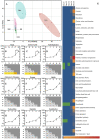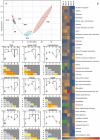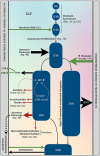Conceptus metabolomic profiling reveals stage-specific phenotypes leading up to pregnancy recognition in cattle†
- PMID: 33590828
- PMCID: PMC8111239
- DOI: 10.1093/biolre/ioab021
Conceptus metabolomic profiling reveals stage-specific phenotypes leading up to pregnancy recognition in cattle†
Abstract
Reproductive efficiency in livestock is a major driver of sustainable food production. The poorly understood process of ruminant conceptus elongation (a) prerequisites maternal pregnancy recognition, (b) is essential to successful pregnancy establishment, and (c) coincides with a period of significant conceptus mortality. Conceptuses at five key developmental stages between Days 8-16 were recovered and cultured in vitro for 6 h prior to conditioned media analysis by untargeted ultrahigh-performance liquid chromatography tandem mass spectroscopy. This global temporal biochemical interrogation of the ex situ bovine conceptus unearths two antithetical stage-specific metabolic phenotypes during tubular (metabolically retentive) vs. filamentous (secretory) development. Moreover, the retentive conceptus phenotype on Day 14 coincides with an established period of elevated metabolic density in the uterine fluid of heifers with high systemic progesterone-a model of accelerated conceptus elongation. These data, combined, suggest a metabolic mechanism underpinning conceptus elongation, thereby enhancing our understanding of the biochemical reciprocity of maternal-conceptus communication, prior to maternal pregnancy recognition.
Keywords: bovine; conceptus; development; elongation; embryo; metabolomics.
© The Author(s) 2021. Published by Oxford University Press on behalf of Society for the Study of Reproduction. All rights reserved. For permissions, please e-mail: journals.permissions@oup.com.
Figures






Similar articles
-
The biochemistry surrounding bovine conceptus elongation†.Biol Reprod. 2019 Aug 1;101(2):328-337. doi: 10.1093/biolre/ioz101. Biol Reprod. 2019. PMID: 31181571
-
Progesterone alters the bovine uterine fluid lipidome during the period of elongation.Reproduction. 2019 Apr 1;157(4):399-411. doi: 10.1530/REP-18-0615. Reproduction. 2019. PMID: 30763281
-
Progesterone and conceptus elongation in cattle: a direct effect on the embryo or an indirect effect via the endometrium?Reproduction. 2009 Sep;138(3):507-17. doi: 10.1530/REP-09-0152. Epub 2009 Jun 25. Reproduction. 2009. PMID: 19556439
-
Embryonic maternal interaction in cattle and its relationship with fertility.Reprod Domest Anim. 2018 Sep;53 Suppl 2:20-27. doi: 10.1111/rda.13297. Reprod Domest Anim. 2018. PMID: 30238655 Review.
-
Pregnancy recognition and conceptus implantation in domestic ruminants: roles of progesterone, interferons and endogenous retroviruses.Reprod Fertil Dev. 2007;19(1):65-78. doi: 10.1071/rd06102. Reprod Fertil Dev. 2007. PMID: 17389136 Review.
Cited by
-
Uterine lumen fluid is metabolically semi-autonomous.Commun Biol. 2022 Mar 1;5(1):191. doi: 10.1038/s42003-022-03134-0. Commun Biol. 2022. PMID: 35233029 Free PMC article.
-
PPARG is dispensable for bovine embryo development up to tubular stages†.Biol Reprod. 2024 Sep 14;111(3):557-566. doi: 10.1093/biolre/ioae083. Biol Reprod. 2024. PMID: 38832705 Free PMC article.
-
The Impact of Uterus-Derived Prostaglandins on the Composition of Uterine Fluid During the Period of Conceptus Elongation in Dairy Heifers.Int J Mol Sci. 2025 Feb 20;26(5):1792. doi: 10.3390/ijms26051792. Int J Mol Sci. 2025. PMID: 40076420 Free PMC article.
-
Biochemical alterations in the follicular fluid of bovine peri-ovulatory follicles and association with final oocyte maturation.Reprod Fertil. 2022 Dec 1;4(1):e220090. doi: 10.1530/RAF-22-0090. Online ahead of print. Reprod Fertil. 2022. PMID: 36547396 Free PMC article.
-
Capture and metabolomic analysis of the human endometrial epithelial organoid secretome.Proc Natl Acad Sci U S A. 2021 Apr 13;118(15):e2026804118. doi: 10.1073/pnas.2026804118. Proc Natl Acad Sci U S A. 2021. PMID: 33876774 Free PMC article.
References
-
- Betteridge K, Eaglesome M, Randall G, Mitchell D. Collection, description and transfer of embryos from cattle 10-16 days after oestrus. J Reprod Fertil 1980; 59:205–216. - PubMed
-
- Hue I, Degrelle SA, Turenne N. Conceptus elongation in cattle: genes, models and questions. Anim Reprod Sci 2012; 134:19–28. - PubMed
-
- Wales RG, Cuneo CL. Morphology and chemical analysis of the sheep conceptus from the 13th to the 19th day of pregnancy. Reprod Fertil Dev 1989; 1:31–39. - PubMed
-
- Wang J, Guillomot M, Hue I. Cellular organization of the trophoblastic epithelium in elongating conceptuses of ruminants. C R Biol 2009; 332:986–997. - PubMed
MeSH terms
Substances
LinkOut - more resources
Full Text Sources
Other Literature Sources

